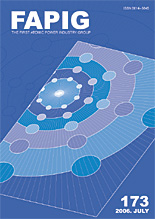![]()
FAPIG
THE FlRST ATOMlC POWER INDUSTRY GROUP
FAPIG誌 最新号目次
2006-7/平成18年度 第1号(No.173)

|
目 次 ■ 報 告 ■ 解 説 ■ 紹 介 ■ グループ情報 表紙デザイン:堀内秀和
CONTENTS ■ Report ■ Commentary ■ Introduction Cover Design:Hidekazu Horiuchi
SYNOPSES Asao Monno, Hideyuki Yuzawa, Tomomitsu Kimura, Taro Kanayama A new system of tube wall thickness gauge for seamless tube on hot
stretch reducing-mill is reported. KEYWORDS:tube wall thickness, thickness gauge, seamless tube hot stretch reducer, gamma rays Takashi Kato Material and life science test facility is under the construction as a part of the Japan proton accelerator research complex (J-PARC) that utilizes an immense proton power (1-MW) accelerator. A 1-MW pulse spallation neutron source, that is the main facility at the material and life science test facility, is one of the world largest spallation neutron sources, utilizing a mercury target and liquid or supercritical hydrogen moderators. The neutron source has been designed and fabricated to exploit a state-of-the-art technology of the spallation neutron source engineering, expecting to produce one or two orders higher neutron intensity than that of the conventional neutron sources at the cold neutron regime. KEYWORDS:J-PARC, neutron, spallation neutron source, cold neutron, mercury target, liquid/supercritical hydrogen moderator Hirokazu Yamada, Kunihiko Tsuchiya SS316L(N)-IG is the candidate material for the in-vessel and ex-vessel components of ITER (International Thermonuclear Experimental Reactor). This paper describes an examination into weldability of irradiated and un-irradiated SS316L(N)-IG for coolant piping, and investigation of the mechanical properties of welding joints as well as the effect of helium generation on weldability. A YAG laser welding process was used for repair welding of the water cooling branch pipelines. It was clarified that welding of SS316L(N)-IG irradiated up to 0.3 dpa (He content:about 3 appm) can be carried out without a significant deterioration of tensile properties due to helium accumulation. Therefore, repair of cooling pipes for the ITER blanket can be performed by the laser welding process. KEYWORDS:ITER SUS316L(N)-IG, laser welding, neutron irradiation, helium generation, helium bubble Kazuki Takehara, Youichi Sasa, Tsutomu Sekita Japan Atomic Energy Agency(JAEA)-Tokai Research and Development Center-Nuclear
Science Research Institute observe the laws of radiation protection
by the environmental monitoring and the meteorological observation around
the nuclear facilities, counting and analyzing of its results, and report
it to related organization. KEYWORDS:environmental radiation monitoring, Japan Atomic Energy Agency, web based system, clustering technology, high availability Junji Suhara, Ryoichiro Matsumoto, Akihito Otani, Takahiro Shimada,
Kazuhiko Inoue, Shinya Ikutama Mitigation of the earthquake loads by seismic isolation technology
is very promising for enhanced safety and economy of the next generation
nuclear power plant. A research for 3D seismic isolation technology
has been conducted under the sponsorship of the Ministry of Economy,
Trade and Industry. Two types of 3D seismic isolation systems were developed.
One is the 3D entire building base isolation system. The other is the
vertical isolation system for main components in the horizontally entire
building base isolation. For the former technology, the メrolling seal
type air spring + hydraulic rocking suppression systemモ is selected
after several studies. KEYWORDS:three-dimensional seismic isolation, fast breeder reactor, air spring, hydraulic mechanism, laminated rubber bearing, rocking suppression, shaking table test Takashi Shimakawa Elevated temperature design standards have been developed in many countries to be applied for the designing of components operated at high temperature such as fossil power plant, petroleum plant and fast breeder reactor. Dominant failure mode considered in these components is creep-fatigue crack initiation under cyclic thermal stress at elevated temperature. It is important to develop the estimation methods for strain behavior and strength under the nonlinear conditions to perform a rational design. This paper presents a comparison among creep-fatigue life prediction methods in representative design codes such as ASME Sec. ⅢNH in USA, BDS and DDS in Japan, R5 in UK and RCC-MR in France. KEYWORDS:elevated temperature design, creep-fatigue life, design standards |
バックナンバー目次
|
号数 |
発行年月 |
| 172 | 2006/ 3 |
| 171 | 2005/11 |
| 170 | 2005/ 7 |
| 169 | 2005/ 3 |
| 168 | 2004/11 |
| 167 | 2004/ 7 |
| 166 | 2004/ 3 |
| 165 | 2003/11 |
| 164 | 2003/ 7 |
| 163 | 2003/ 3 |